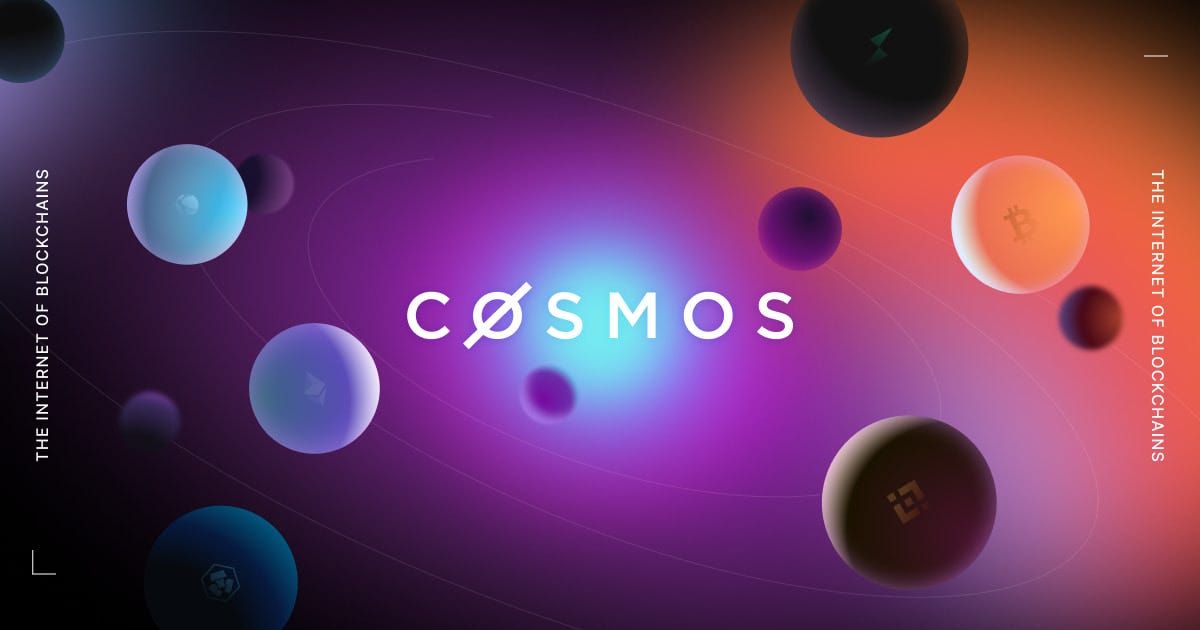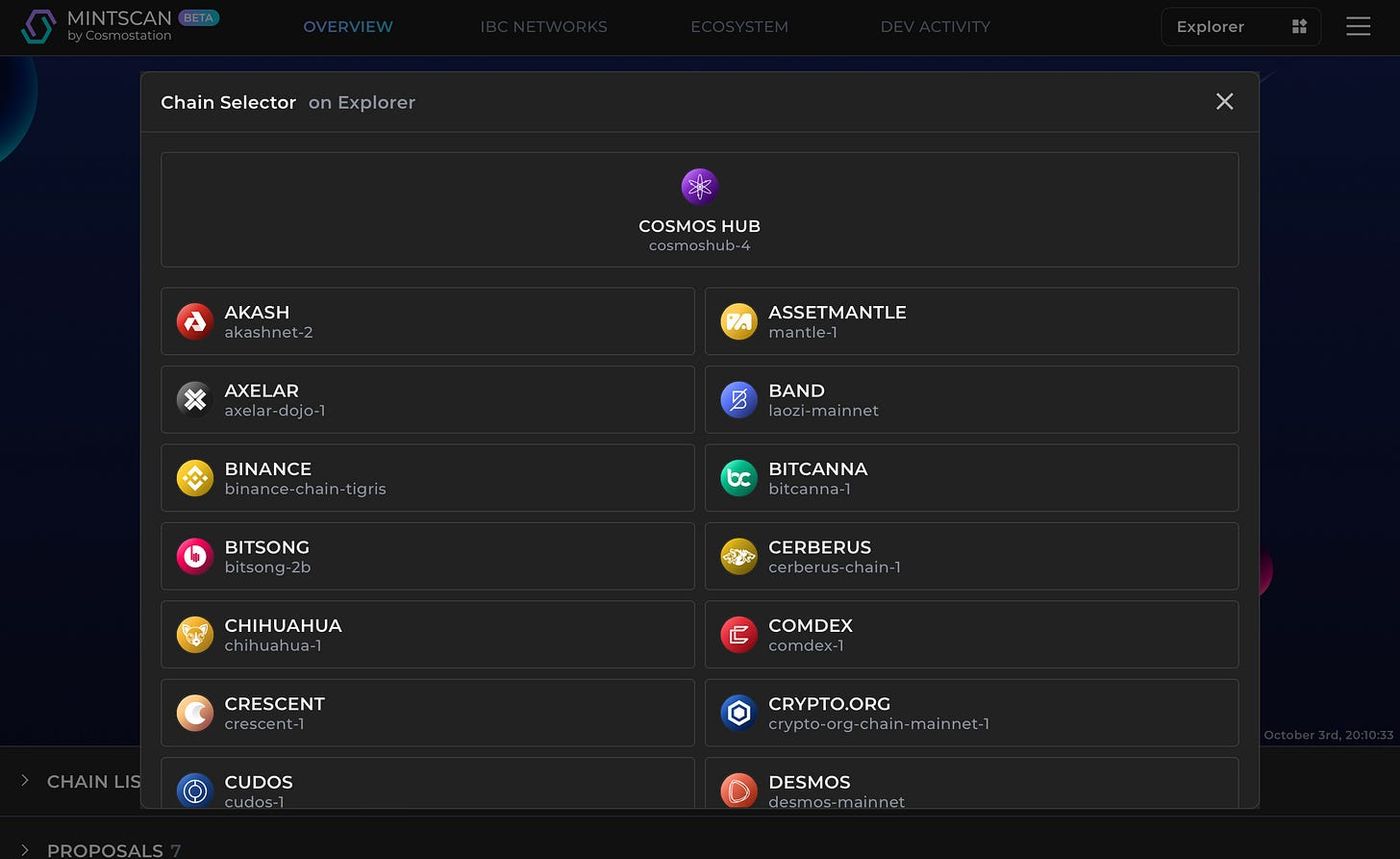Cosmos 2.0: Seaport City, Cross-Chain Security and the New Value of ATOM
Last week there were big events in the currency circle around the world, and the one that impressed me the most was the Cosmos 2.0 development blueprint proposed by Cosmos Hub, the leader of the Cosmos ecosystem. This post will briefly explain the Cosmos ecosystem before discussing the biggest highlights of Cosmos 2.0.

If you've ever wanted to buy and sell Cosmos ecosystem cryptocurrencies on a centralized exchange, you'll find that most exchanges only open deposits and withdrawals with Cosmos Hub's ATOM coins. Users must buy ATOM coins before they can enter the Cosmos ecosystem. In addition to operational considerations, the fact that various exchanges only list ATOM may also have something to do with Cosmos Hub's self-proclaimed "harbour city".
harbour city
In the past year, everyone is no longer unfamiliar with the concept of cross-chain (Cross-Chain), but in fact, as early as 2016, cross-chain is the DNA built into the entire Cosmos ecosystem.
If every blockchain is a city, cross-chain is like moving between different cities. Haseeb Qureshi, founder of the venture capital Dragonfly, likened Ethereum to New York with an inch of land, and Solana to Los Angeles. Cosmos Hub, on the other hand, prides itself on being a " harbour city " that extends in all directions, and cross-chain is the most familiar daily life in this city.
The world view of the seaport city (Cosmos Hub) is very different from that of the financial metropolis (Ethereum). Ethereum wants to be the "world computer" that every developer can easily write on. Cosmos wants to build an "internet of blockchains", which not only allows developers to quickly build their own blockchains, but also communicate with each other through a cross-chain mechanism to form a close collaborative network.
It sounds abstract, but just open a cryptocurrency wallet to get a glimpse of the difference. Take the most familiar MetaMask wallet as an example, MetaMask will create a set of wallet addresses starting with 0x for the user, and all the applications of Ethereum can be accessed with this set of addresses.
But if you download wallets of the Cosmos ecosystem such as Keplr or Cosmostation , you will find that the wallet app will automatically create several wallet addresses of different blockchains for you in case you need it. The beginning of each wallet address is different. For example, the address of Osmosis starts with osmo, and the address of LikeCoin will start with like.

The difference between the two ecosystems can be seen from the wallet interface. Ethereum wants users to stay in one blockchain, and cross-chain is a last resort. But the Cosmos ecosystem encourages everyone to jump between different blockchains, and cross-chain is commonplace.
Taking the buying and selling of cryptocurrencies as an example, Cosmos users must first transfer the cryptocurrencies to the Osmosis blockchain to start trading, but Ethereum users can directly buy and sell as long as they connect to the Uniswap website. There are many users who are familiar with Ethereum and often feel uncomfortable jumping to the Cosmos ecosystem. Just like people who are accustomed to living in a big city, they often feel that the country is inconvenient when they return to the countryside, and it is very far to go anywhere.
While Cosmos users often have to “commute” between different blockchains, it can be quite a hassle, but it also brings two major benefits. The first is blockchain autonomy. Each application can create its own blockchain, and the application can also be highly customized technically. The second is user diversion. When the crowd is dispersed to different blockchains, the transaction is not easy to be stuck in traffic. This is something that Ethereum residents can hardly imagine.
After the overall Cosmos ecosystem has begun to take shape, the Cosmos Hub proposed a new upgrade plan last week, The Cosmos Hub. However, this name has been used as early as 2017. In order to distinguish it from the past content, the community generally calls it Cosmos 2.0 .
Cosmos 2.0
According to the proposal narrative :
We presented a new Cosmos Hub Vision Document. Unlike what was published in 2017, the focus was on building an internet of blockchains interconnected by IBC. The original vision of the Cosmos Hub has been realized. This new document signifies the Cosmos Hub's transition to the next stage as an infrastructure services platform, and the new positioning of ATOM as the collateral of choice in the Cosmos ecosystem.
Most people are relatively new to the Cosmos ecosystem. It is difficult to clarify the relationship between the Cosmos ecosystem and the Cosmos Hub, let alone the specific upgrade content of Cosmos 2.0.
The image below is a screenshot of the blockchain browser Mintscan. The combination of all the blockchains listed in the figure is called Cosmos Ecosystem 2, and the Cosmos Hub at the top of the figure is the first blockchain in the Cosmos ecosystem

Each blockchain in the Cosmos ecosystem has its own token. For example, the token of Cosmos Hub is ATOM, the token of Osmosis is OSMO, and the token of LikeCoin is LIKE.
Each blockchain has a clear function, for example Osmosis is a decentralized exchange3, and LikeCoin is a decentralized publishing house4. On the contrary, the Cosmos Hub is hard to say what the specific purpose is except that it is the first blockchain in the ecosystem. This is where Cosmos 2.0 wants to improve - to find a unique position for the Cosmos Hub and ATOM token.
Initially, the Cosmos Hub hoped to be the first blockchain that can be used in the entire Cosmos ecosystem, and it was also the entrance for people to enter the Cosmos ecosystem - a seaport city - and later, most exchanges also listed ATOM tokens. However, with the vigorous development of the Cosmos ecosystem, each "inland city" has developed its own characteristics, which has put pressure on the Cosmos Hub to transform and upgrade.
Among them, Interchain Security proposed by Cosmos 2.0 has the most far-reaching impact on Cosmos Hub and ATOM coins.
Cross-chain security sharing
Each blockchain in the Cosmos ecosystem is independent. In other words, each blockchain has to recruit its own validators (miners) to keep the blockchain safe.
Like the block potential is one of the 49 validators in the LikeCoin blockchain5, and the overall LIKE market value is about more than 3 million US dollars. If a hacker wants to launch a 51% attack, it may "just" spend tens of millions of dollars (the token will become more expensive) to buy a large number of LIKE coins from the market to become a validator, and have a chance to succeed.
In contrast, the Cosmos Hub blockchain has a total of 175 validators, and the overall ATOM pledged market value is as high as $ 2.5 billion . If hackers want to launch a 51% attack on the Cosmos Hub, if they are not prepared to sweep the ATOM market with billions of dollars, I am afraid it will be difficult to succeed.
From an economic incentive point of view, Cosmos Hub is much more secure than LikeCoin. Cosmos 2.0 makes good use of its strengths to provide cross-chain security sharing, open other blockchains with smaller market capitalizations, and directly "rent" security from the Cosmos Hub.
For the newly established blockchain, this is equivalent to a kind of "decentralization-as-a-service". Blockchain developers can obtain the same security as Cosmos Hub without recruiting nodes and maintaining currency prices themselves. For validators who stake ATOM, this is equivalent to another passive income, and of course they are happy to help.
The way to pay the "rent" is also very simple, just change all the transaction fees of the blockchain to ATOM. Cosmos Hub will pay 25% of the income (the proportion to be determined) to ATOM validators; the other 75% will be used as a fund to finance public goods, which will be used for the development of new blockchains.
This can be said to be a gorgeous turn of the Cosmos Hub and ATOM. It is precisely because of the early development of ATOM that it has the opportunity to be listed on major exchanges and squeezed into the top 25 in the world by market value. But with the development of the Cosmos ecosystem, the greatest value of the Cosmos Hub has now been transformed from the first city in the ecosystem to the transportation hub of the ecosystem.
While newcomers (money) won't stay in the Cosmos Hub for long, Cosmos 2.0 finds new value for the city. Let the old city shelter the development of the new city and reap the rewards from the prosperity of the new city. However, as an urbanite who is already familiar with the convenience of the urban area, I am afraid that it will take some time to slowly adapt to the new "commuting" life rhythm.
Block Potential is an independent media that is maintained by readers' paid subscriptions, and the content does not accept factory or commercial distribution. If you think the block potential article is good, please share it. If the bank has spare capacity, it can also support the block potential operation with a regular quota. To view the content of past publications, you can refer to the article list .
Further reading
- Multiple chains coexist or one chain dominates? Blockchain is a city, not a network
- A Beginner's Guide to the Cosmos Ecosystem
- Overcurrent Collateral: Osmosis perfectly combines PoS with liquidity mining
- Writing NFT: For less than 1 yuan, you can publish digital creations with book specifications
- Block Potential Becomes LikeCoin's Blockchain Validator
Like my work? Don't forget to support and clap, let me know that you are with me on the road of creation. Keep this enthusiasm together!




- Author
- More